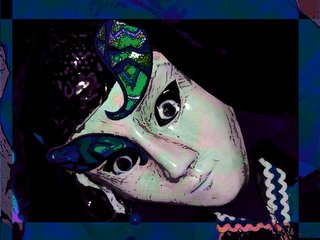Argus Den
Things worth knowing.... Random facts.... Inspiration for the uninsipred.
Saturday, January 07, 2006
Friday, January 06, 2006
Vestal's lot
- (quoting Alexander Pope)
- "How happy is the blameless vestal's lot!
- The world forgetting, by the world forgot.
- Eternal sunshine of the spotless mind!
To raise the genius, and to mend the heart;
To make mankind, in conscious virtue bold,
Live o'er each scene, and be what they behold:
For this the Tragic Muse first trod the stage."
Prologue to Mr. Addison's Cato (1713), line 1
My Mother's Book (Spelldown) News
SPELLDOWN by Karon Luddy. 13-year old Karlene Bridges has had just about enough of Red Clover, South Carolina. With her older sister, Gloria Jean gone and married, Karlene is left to care for her young twin brothers, take care of Mama, and make sure Daddy lays off the alcohol. On top of that, Karlene has a National Spelling Bee to win.
Karlene has that fresh irreverence that might make some take her for a smart-aleck like the time she corrects Mrs. Helms' pronunciation of hierarchy. Reading Whitman and Hemingway help Karlene make sense of the world, and with the butterfly-inducing Billy Ray to offer comfort, and the mentoring of Mrs. Amanda Harrison, Latin teacher extraordinaire, Karlene finds her way to young adulthood. This is a coming of age story for the ages.
Talia Cohen sold North American rights to Simon & Schuster for publication next summer. We retain translation rights.
http://ldlainc.com/news.html
Thursday, January 05, 2006
What is a Mandala?
Mandala, (Sanskrit for circle) is a traditional form of Tibetan Buddhism. Mandalas are drawings in three-dimensional forms of sand. In Tibetan, this art is called "dul-tson-kyil-khor", "mandala of colored powder".
Millions of grains of sand are painstakingly laid into place on a flat platform over a period of several days.
After spending days placing each grain of sand into intricate patterns to form a beautifully detailed picture, the monks destroy their work by sweeping up the colored sands and dumping them into a nearby source of running water so that the healing energies can be spread throughout the world. This ritualistic destruction is supposed to symbolize the impermanence of all things.
Mostly made of colored sand, a mandala can also be created in powdered flowers, grains or herbs. In ancient days, precious and semi-precious gems were ground into a powder and used.
There is a ritual to creating a mandala that begins with an opening ceremony. The monks consecrate the site as they call forth the forces of goodness by chanting mantras while others play flutes, drums and cymbals.
After the ceremony, an outline of the mandala is drawn on a wooden platform, so that over the next few days, colored sand can be poured into the pattern using tiny metal funnels called "chakpur." To get the sand to flow through the chakpur, the funnel is scraped with a metal rod to cause enough vibration for individual grains of sand to trickle out of it. The two chakpurs symbolize the union of wisdom and compassion.
All mandalas have three meanings an outer, an inner, and a secret level of meaning. The outer level represents the world in its divine form. On the inner level, the monks create a map by which the ordinary mind is transformed into the enlightened mind. On the secret level, the monks predict the primordially perfect balance of the subtle energies of the body and the clear light dimension of the mind. Making a mandala is supposed to cause purification and healing on all three levels. http://www.gomangtour.org/goal.html
Monday, January 02, 2006
Sunday, January 01, 2006
Inspiring words from Gandhi
Gandhi's Seven Deadly Sins
Mohandas Karamachand Gandhi, one of the most influential figures in modern social and political activism, considered these traits to be the most spiritually perilous to humanity.
Wealth without Work
Pleasure without Conscience
Science without Humanity
Knowledge without Character
Politics without Principle
Commerce without Morality
Worship without Sacrifice




